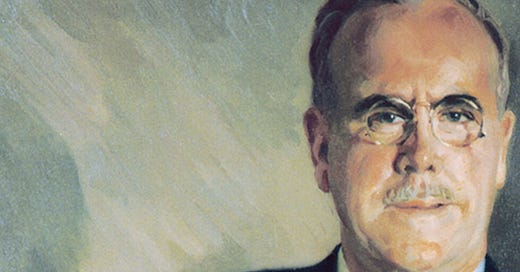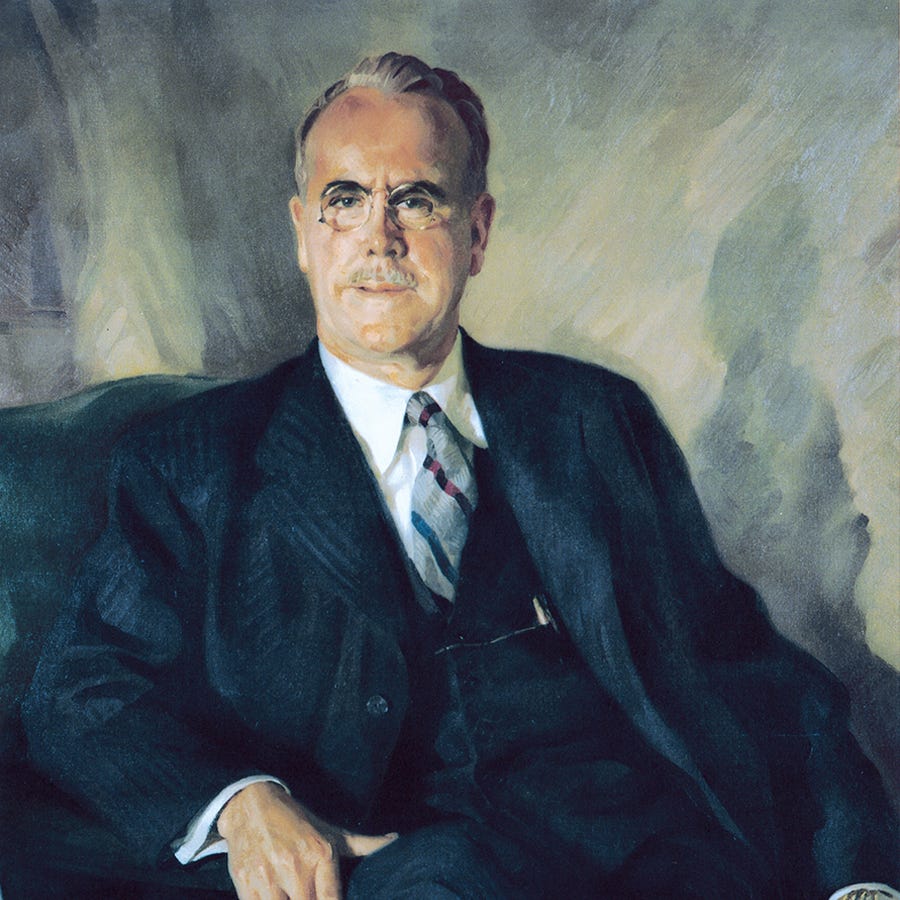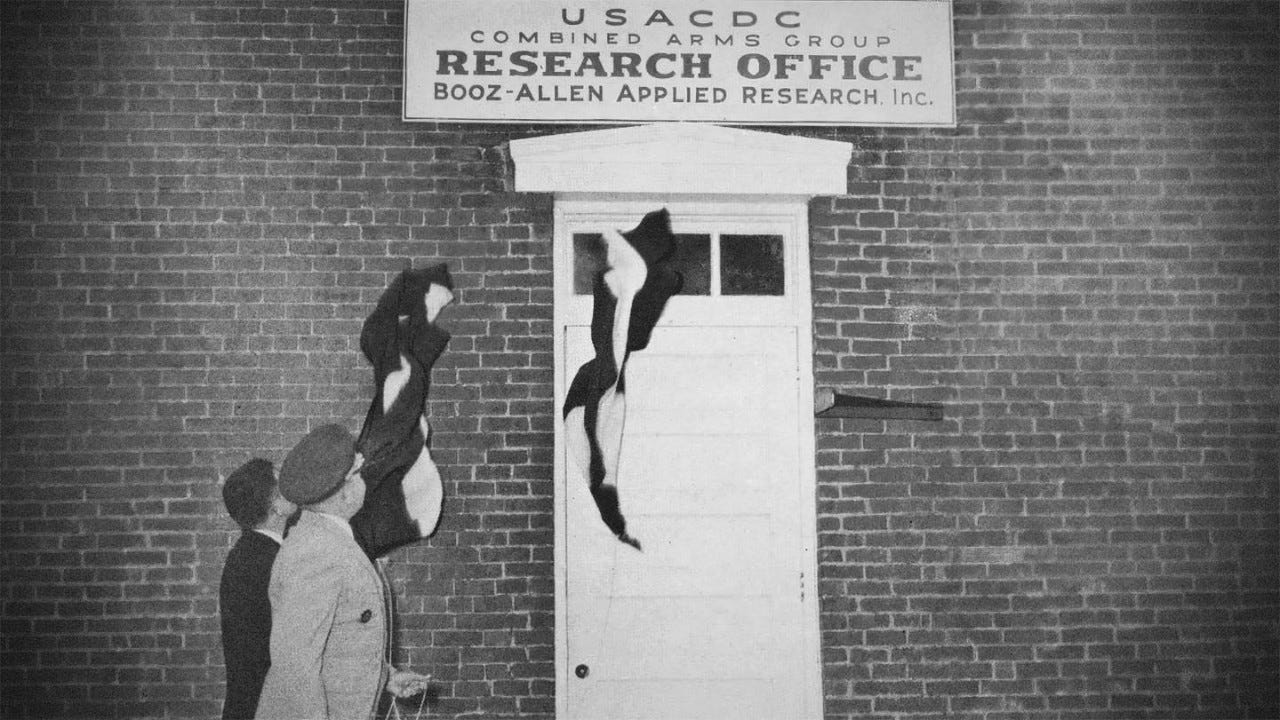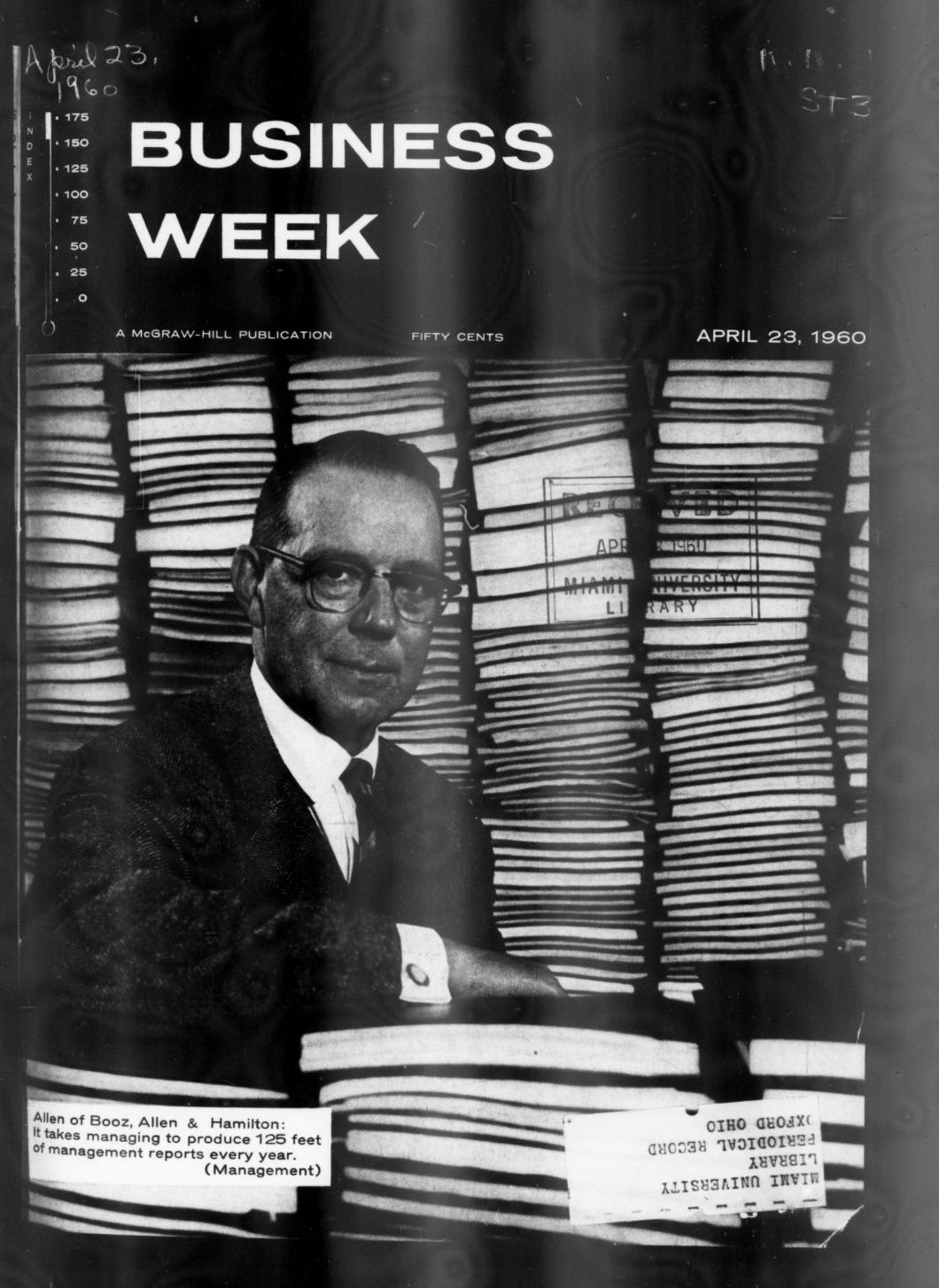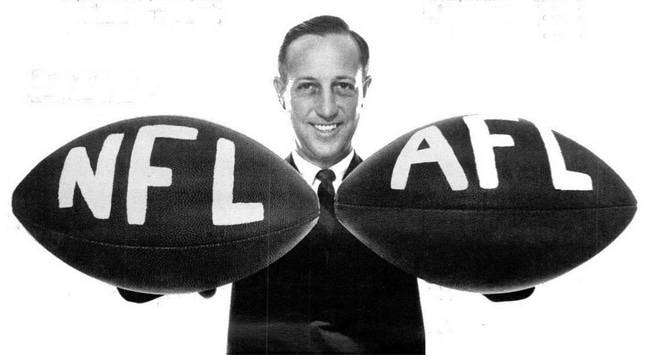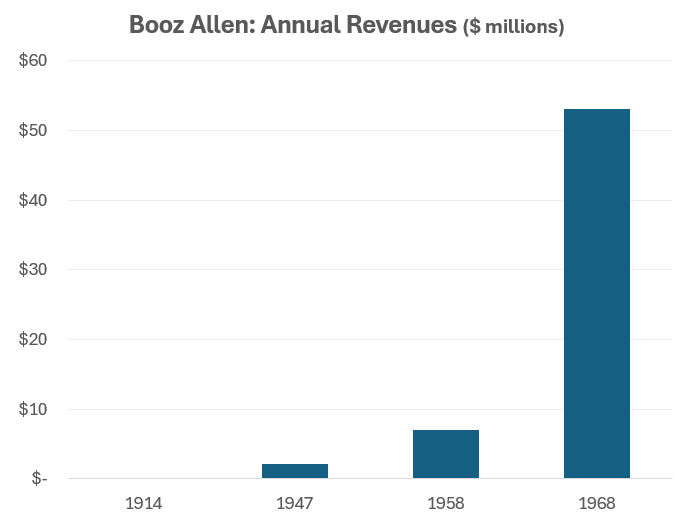“The business of advising management is based on the principle that companies, like people, are generally unable to see themselves as others see them. The soundness of the principle is proved by the fact that the management-consultant business, which has been expanding for years, is booming as it never has before. U.S. industry is now paying at least $65 million a year for outside advice…. And most of the $65 million is spent not by sick companies but by healthy ones, eager for any idea that promises to increase the gap between revenue and outgo.”
“Doctors of Management”, Fortune, July 1944
The story of Booz Allen Hamilton is more than just the history of a consulting firm. It’s a narrative deeply intertwined with the evolution of business, the rise of technology, and the major global events of the 20th century. Founded on the principle of providing expert, external advice to organizations, the firm has consistently adapted and innovated, leaving an indelible mark on both the commercial and public sectors. Join me as I delve into the formative years of Booz Allen Hamilton, from its humble beginnings in Chicago to its emergence as a global consulting leader.
The Vision (1914-1935)
Edwin George Booz, the fifth of seven sons, was born in 1889 to Thomas H. and Sally Booz. Ed’s mother died when he was only four years old. Despite this tragedy and despite not being born into wealth, Booz was accepted to Northwestern University in 1908 where he earned degrees in economics (1912) and psychology (1914). His master’s thesis, “Mental Tests for Vocational Fitness,” demonstrated his interest in the human element of organizations. Booz completed his thesis under the advisement of Walter Dill Scott, a pioneer in the field of industrial psychology.
According to the Encyclopedia of Entrepreneurs (1997):
“While in graduate school, [Edwin] worked for 16 months as an advertising statistician for Woman’s World, a large Chicago-based magazine. The man who hired him was so impressed with Booz’s work that he urged him to establish his own business. Upon graduation in 1914, Booz took the advice and hung out his shingle.”
Almost immediately after graduation, Booz borrowed $500 from the local bank and set up a small consulting firm in Chicago. The initial name was the Business Research Service. The firm focused on conducting studies and investigations for commercial and trade organizations, a service Booz proudly claimed as the first of its kind in the Midwest. Booz strongly believed that companies could achieve greater success by seeking objective advice from outside their own structures.

Early clients included prominent names such as Goodyear Tire & Rubber Company, Chicago’s Union Stockyards and Transit Company, and the Canadian & Pacific Railroad. These early, and successful, engagements demonstrated the value of Booz’s approach: in-depth analysis leading to practical recommendations.
However, just three years after the founding of Business Research Service, Booz was drafted into the U.S. Army as World War I intensified. During his military service, he worked under his former professor Walter Dill Scott who was managing the Army’s personnel system. In just two years, Booz advanced from private to major in the Inspector General’s Department.
Booz’s rapid rise can be traced to his background in psychology at Northwestern. While a graduate student, he formulated the idea of combining psychological techniques with practical judgment to match individuals with roles that suited their skills. The goal of this approach was to enhance organizational efficiency and the Army was the ideal environment to test Booz’s theories.
Booz applied his business acumen to tasks such as centralizing personnel management, analyzing reports, and organizing statistical data. His contributions not only supported the war effort but also provided valuable insights that shaped his post-war career.
In 1924, to more accurately reflect its core activities, Edwin changed the name of the firm to Business Surveys. Unlike some contemporary “efficiency-engineering” firms, Booz adopted a more personnel-oriented, applied-psychology approach, incorporating employee interviews into the study of organizational structures. This focus on the human element would become a defining characteristic of the firm’s methodology.
In 1925, Booz would hire George Fry—another Northwestern alumnus—as his first full-time assistant. That same year, U.S. Gypsum Company became a significant client, a relationship that lasted throughout the decade. Other notable clients during this period included the Chicago Tribune, Hart Schaffner & Marx, and the Chicago Daily News. In 1929, James L. Allen, a recent graduate from Northwestern, joined the firm, which had by then moved its office into the new Chicago Daily News Building. In 1935, Carl Hamilton, “a 47-year-old marketing whiz” from Weyerhauser, joined the firm as a partner.

The Partnership Years (1936-1949)
The mid-1930s brought significant changes. In 1936, after helping Montgomery Ward recover financially using his “multi-vector” executive appraisal method, Booz hired Carl Hamilton and reorganized his firm into a partnership: Booz, Fry, Allen & Hamilton. By the late 1930s, the firm’s marketing highlighted that its “independence … enables us to say plainly from the outside what cannot always be said safely from within.” They also began offering executive recruiting services. A landmark achievement during this period was Booz’s first-ever study of a nationwide institution, the American National Red Cross, which propelled the firm into institutional consulting.
Booz Allen took on another significant assignment to improve the management and operations of Montgomery Ward in 1938. Montgomery Ward was running a “poor second” to Sears at the time under the leadership of Sewell Avery. With Avery having formerly worked Booz back in 1925 to streamline the operations of U.S. Gypsum, it was not a surprise that Avery hired Booz Allen for advice on how to catch up to Sears.
The 1940s marked another crucial turning point with the firm’s entry into military consulting. As the United States entered World War II, the firm’s work expanded to include assignments for the Army and the War Production Board. However, this period saw internal friction, leading to the temporary departure, and eventual return, of James Allen, as well as the resignation of George Fry. The firm was then renamed Booz Allen & Hamilton.
But getting back to the opportunity to serve the country as well as a new customer segment, it was U.S. Navy Secretary Frank Knox, a former publisher of the Chicago Daily News, who hired the firm in 1940. The assignment was to assess the Navy’s preparedness for war, including evaluations of shipyards, telephone systems, and intelligence operations.
One of the first recommendations Booz and Allen offered to the Navy was to expand and create a permanent headquarters, a suggestion quickly approved by President Franklin Delano Roosevelt. Booz Allen then assisted in upgrading outdated phone systems and reorganizing mail distribution for the Navy. The following is an excerpt from the October 5, 1942, edition of Newsweek:
“At the approach of war, the Navy Department began to expand enormously. The number of employees has now increased from 5,000 to more than 20,000; phone calls handled by department operators have shot up to 50,000 daily; and mailroom clerks cope with 30,000 bags of mail a month.
Secretary of the Navy Frank Knox called in the firm of Booz, Allen & Hamilton, Chicago management engineers. Led by Edwin G. Booz as specially appointed assistant to the Secretary, the Chicagoans surveyed every bureau in the Navy. In one case, a bureau with 21 sections ended up with five. Because it often took two days to get a letter from one office to another right down the hall, they installed a department mail supervisor to expedite the flow of written communications within the building. They substituted a modern automatic-telephone system for the old-fashioned manual type. The office of Chief Clerk became the Administrative Office of the Navy Department, headed by Rear Admiral H. V. Butler, for the full-time job of running the department smoothly, handling problems of supply and equipment, space, record-keeping, etc.
The efficiency men even adopted employees’ suggestions at $10 to $500 per idea used. At one worker’s suggestion the Bureau of Naval Personnel, which formerly wrote letters confirming the promotion of officers after they had already been notified by wire, cut out these letters altogether and with them seven slow processes of sealing, signing, mailing, etc. With 14,000 naval officers appointed in a single batch recently, the improvement brought a huge saving in paper work.”
Secretary Knox later famously stated in 1944 that the Navy had never spent money “more effectively” than by hiring Booz Allen, with the firm eventually having advisors in every department of the Navy. The firm’s successful engagement with the Navy established a longstanding relationship with the U.S. Federal Government, one that remains firmly in place to this day.
By the end of World War II, Booz Allen had nearly 400 clients nationwide, served by offices in Chicago, New York, and Los Angeles. In 1946, James L. Allen became chairman following Hamilton’s death. The following year, Edwin G. Booz retired, leaving Allen to lead the firm’s governing board. Post-war work included assignments for S.C. Johnson and Radio Corporation of America (RCA). Their work for the federal government continued in peacetime, with a 1947 Air Force contract for the original production management study on guided missiles. Between 1949 and 1955, Booz Allen secured numerous “Wright Field assignments” focusing on missile production capabilities.
Global Expansion and Diversification (1950-1959)
The 1950s marked a period of significant global expansion and increasing technological awareness for Booz Allen. At the start of the decade, they were one of only a handful of large management consulting firms in the United States. They continued to serve their traditional Midwestern manufacturing clients, adding names like Maytag, Parker Pen, and Cessna.
Then in 1951, Edwin G. Booz passed away. In the obituary in the New York Times mentioned Booz had said in a 1949 interview “that the luckiest thing that ever happened to him was his childhood poverty.” He worked his way through college waiting tables and also as a baby sitter.

With the passing of Booz, he left behind a firm poised for international growth and diversification. 1953 saw Booz Allen’s first international contract, a project to study and reorganize land-ownership records for the newly formed Philippine government. Around the same time, they began working with the governments of Egypt on customs operations and a state-owned textile manufacturer. By the mid-1950s, Booz Allen had established an international subsidiary and expanded into Italy, conducting studies for a nationalized steel company and a state-owned oil company.
A crucial development in 1955 was the formation of Booz Allen Applied Research, Inc. (BAARINC) as a separate corporate entity. Leveraging their Wright Field studies on missile production, Booz Allen built BAARINC around a team of guided missile specialists. The goal of the new group was to spearhead the firm’s diversification into the intelligence arena. BAARINC soon secured contracts with the federal government to analyze Soviet missile manufacturing and development.
Booz Allen Engineer Fred Pitts—who joined BAARINC in 1962—recalled how one successful mission led to the next:
“We did work on advanced Navy planning and planning their projects, including communications projects,” said Fred. “And that grew into work with NASA at Goddard Space Flight Center, where we assisted them in operating this spacecraft test facility. Every spacecraft that was going to go into orbit in a scientific experiment setting had to go through these test procedures: shake, rattle, and roll, and vacuum chambers. We created programs that monitored and measured all those results for NASA, and that led us to work with NASA headquarters downtown, where we got involved in supporting management of some of the NASA programs.”
During the late 1950s, Booz Allen also collaborated with NASA, assisting in determining the best approach to reach the moon. They also served on a Navy task force that developed PERT (Program Evaluation and Review Technique), designed to improve the planning and production of the Polaris submarine missile. By the end of the decade, Booz Allen had also contributed to observatory satellites for NASA, improving their lifespans from days to over a decade.
By the close of the 1950s, TIME magazine hailed Booz Allen as “the world’s largest, most prestigious management consultant firm.” The firm had served a vast majority of the largest U.S. businesses, federal government departments, and non-profit institutions. The firm’s partner numbers grew significantly and their professional staff exceeded 500, with a third being specialists.
Transition and New Challenges (1960-1969)
The 1960s brought structural changes and new challenges. In 1962, to implement profit-sharing and retirement plans for its partners, Booz Allen became a private corporation and dissolved the legal partnership. James Allen became the new corporation’s chairperson and Charlie Bowen became president. BAARINC expanded through acquisitions, including Designers for Industry and Foster D. Snell Laboratory. BAARINC eventually became a Booz Allen subsidiary itself with a diverse client list that included the likes of IBM, Abbott Labs, United Airlines, and the U.S. Department of the Interior.
Booz Allen’s non-federal government work during this time included studies for Nassau County, Louisiana, and the Chicago public school system. In the corporate sector, they assisted Johnson Wax in European expansion, aided Deere & Company in restructuring, and facilitated the merger of Rockwell Standard and North American Aviation. International expansion continued in Europe and in South America. The firm also undertook projects in the Middle East and North Africa related to oil operations.
During the Vietnam War, Booz Allen conducted studies for Secretary of Defense Robert McNamara, including feasibility studies for the Supersonic Transport plane. They also provided the U.S. military with assessments of communications equipment in their first “field work” assignment. By 1969, Booz Allen was the largest consulting firm in the United States. The firm had 15 major offices across five continents and was generating substantial annual revenues. This explosive growth led to a debate within the firm regarding the ethics of public ownership for a company emphasizing confidentiality.
A notable, yet perhaps lesser-known, contribution during this decade was Booz Allen’s involvement in the 1966 merger of the American Football League (AFL) and the National Football League (NFL). NFL Commissioner Pete Rozelle sought an impartial outsider to help broker this complex merger and turned to Booz Allen and Jim Farley. Booz Allen provided counsel on antitrust hurdles, mediated disputes, and brought an objective perspective to the negotiations. This work was instrumental in paving the way for the modern NFL and the Super Bowl.
Going Public, Going Private (1970-1979)
The 1970s was yet another period of crucial change. Two other storied business service firms went public in 1969 and 1970. One was Arthur D. Little (ADL) in October 1969. ADL, founded in 1886 and formally incorporated in 1909, was a direct competitor to Booz. The other firm was J. Walter Thompson in January 1970, the world’s largest and oldest ad agency at the time. With annual revenues above $50 million in 1968, the time was ripe for a company like Booz Allen to go public.
Please subscribe to the Andvari Substack so you will be notified of the release of Part II of this history on Booz Allen.
In Part II, I will share detailed financials of the firm during its first time as a public company (1970-1976), how and why they went private in 1976, and what happened in the interim before they emerged again as a publicly traded company in 2010.
Sources and Further Reading
“Red Cross Assayed”, TIME, May 25, 1931.
“Sears and Ward: Watch Them Run”, Business Week, April 1, 1939.
“Desk Victory”, Newsweek, October 5, 1942.
“Doctors of Management”, Fortune, July 1944.
Raynes, James E. “The Problem of Personnel Administration in the United States Navy”, Master of Arts diss., (Leland Stanford Junior University October, 1947).
“The Company Doctors”, TIME, November 23, 1959
“Management Experts Thrive on Own Advice”, Business Week, April 23, 1960.
“2 Federal Agencies Called Inefficient”, New York Times, Nov. 23, 1960.
“Consultants Invade Non-Profit Field”, New York Times, July 21, 1968.
“Pentagon Forms Cost Study Group; Aim Is to Improve Efficiency of Any Major Build-Up”, New York Times, May 28, 1969.
“Booz, Allen Files Offering of Stock”, New York Times, Dec. 12, 1969.
“Booz, Allen and Salomon Fill Key Positions”, New York Times, Sept. 29, 1970.
Kleiner, Art. Booz Allen Hamilton: Helping Clients Envision the Future. Old Saybrook, Conn.: Greenwich Pub. Group, Inc. 2004.
Devany, Reed. “Booz Allen and the Development of Operations Research in the 1950-1960s”, Informs.
“Booz Allen & Hamilton Inc.”, Encyclopedia.com, accessed March 12, 2025.
“Booz Allen & Hamilton Inc. History”, FundingUniverse.com, accessed March 12, 2025.
Disclaimers for this Substack
The content of this publication is for entertainment and educational purposes only and should not be considered a recommendation to buy or sell any particular security. The opinions expressed herein are those of Douglas Ott in his personal capacity and are subject to change without notice. Consider the investment objectives, risks, and expenses before investing.
Investment strategies managed by Andvari Associates LLC, Doug’s employer, may have a position in the securities or assets discussed in any of its writings. Doug himself may have a position in the securities or assets discussed in any of his writings. Securities mentioned may not be representative of Andvari’s or Doug’s current or future investments. Andvari or Doug may re-evaluate their holdings in any mentioned securities and may buy, sell or cover certain positions without notice.
Data sources for all charts come from SEC filings, Koyfin, and other publicly available information.

